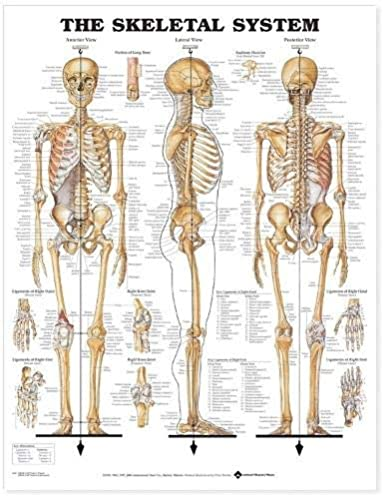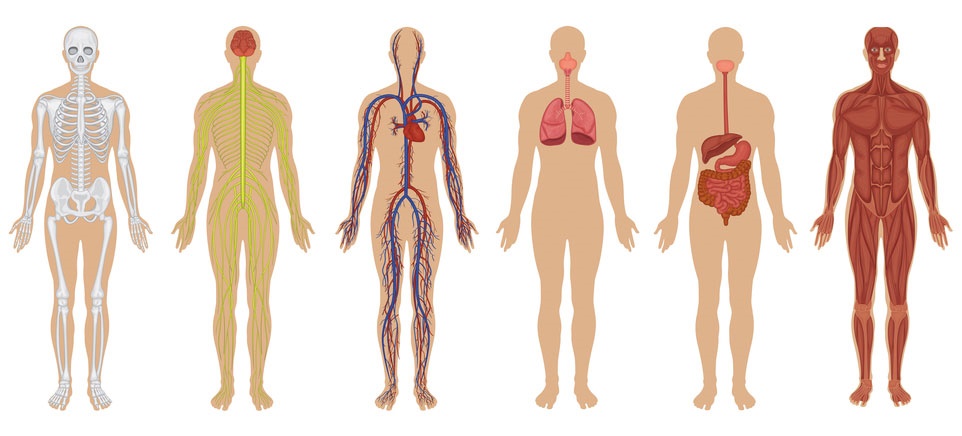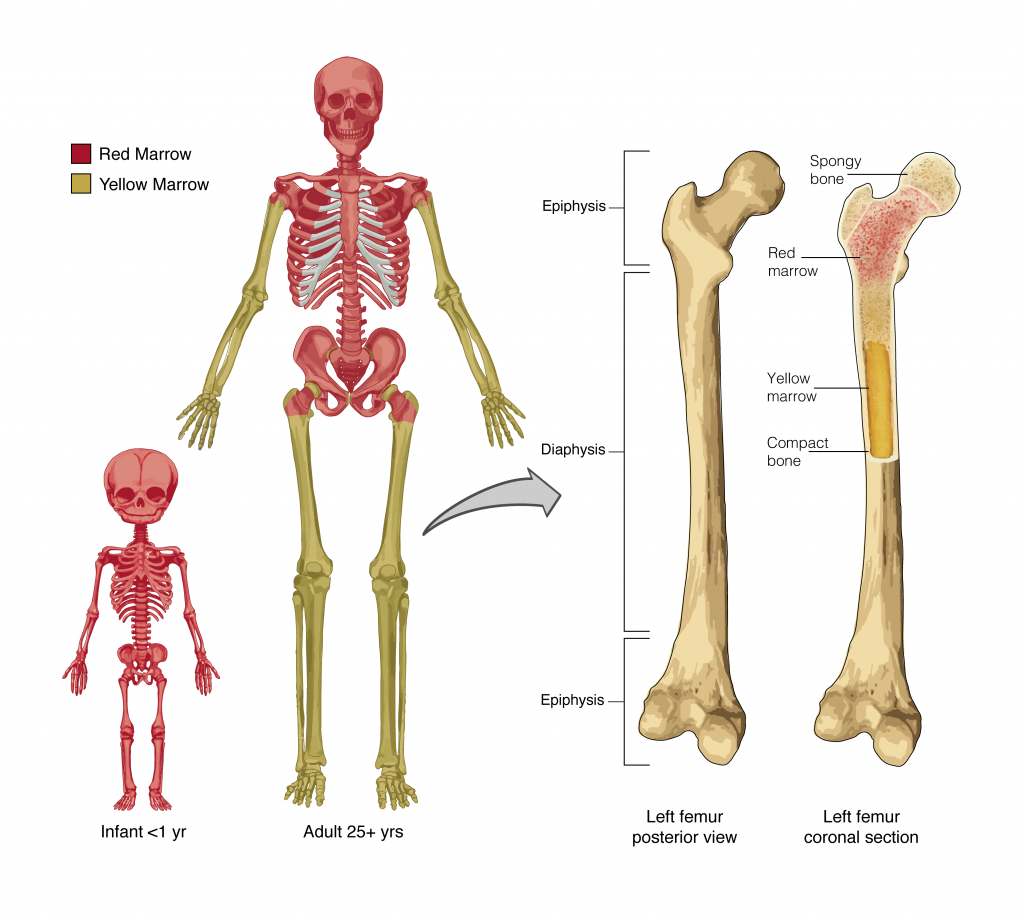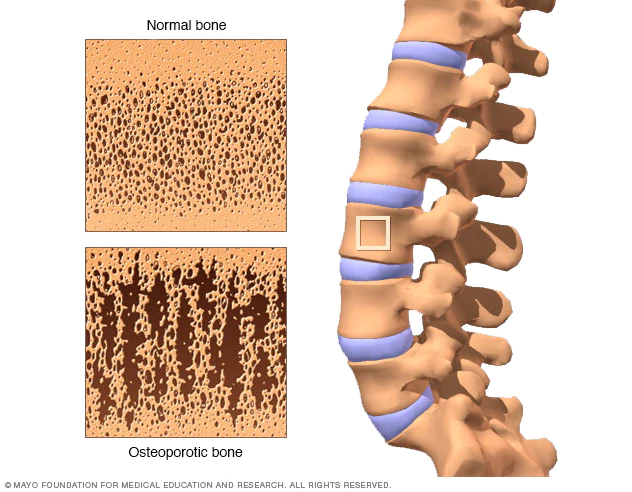The Anatomy of the Skeletal System

The skeletal system is located in the whole body and may be divided into two parts: the appendicular skeleton and the axial skeleton.
Researchers note that “the axial skeleton runs along the body’s midline axis and is made up of eighty bones,” including, for example, skull, ribs, hyoid, and sternum (Taylor, 2020, para. 3). The appendicular skeleton is comprised of and located in the upper limbs, lower limbs, pectoral girdle, and pelvic girdle (Taylor, 2020). The skeletal system consists of four organs – the ligaments, which assist in holding organs in their places, connect the ends of bones, and form joints.
Tendons are tissues connecting bones to muscles, cartilage tissues that connect the bones, support movements, and hold the skeleton and bones in the body (Seladi-Schulman, 2018).
Ligaments are small bands of elastic, fibrous, dense, and white tissue. The organ’s main function is connecting the bones. Ligaments have a viscoelastic feature, which allows them to strain under tension and return to the initial state once it is removed (Walker, 2020).
Tendons are inelastic, flexible, and tough bands of fibrous connective tissue connecting bones to muscles. The main cellular component of tendons are tenocytes, which synthesize the extracellular matrix of tendons. Unlike Ligament tissue, tendons are capable of oppressing the tension.
Cartilage is a resilient and smooth elastic tissue, composed of specialized cells called chondrocytes (Walker, 2020). The organ covers and protects the ends of long bones at the joints and nerves. Due to its structure, cartilage’s main function is holding tubes open in the body.
Bones are breathing and living organs that are made of cells and change and grow with the rest of the body. They are responsible for various functions as a protection of organs, enabling of mobility, generation of red and white blood cells, minerals storage.
The Organ System’s Location Relative to Other Organ Systems

The main physiological functions include the provision of the body’s shape, support and movement, blood-cell formation, triglyceride storage, protection, and mineral homeostasis. The bone structure facilitates the movements and protects the soft organs. The bones and cartilages compose the framework that supports the entire body. It also gives a shape to the mass, as without the skeletal organs, a person would not be able to function.
The bones of the skeleton also protect the internal organs from damages. Due to their rigid structure, osseins surround and cover the organs, subsequently preventing them from external hazards.
Another viral function of the skeletal system is mineral homeostasis. In the body, bones are the critical reservoirs for minerals, especially calcium and phosphorus, vital for maintaining the homeostasis of minerals in the blood.
The skeletal system is also responsible for blood-cell production, which is formed in the bone marrow. There are two types of bone marrow – red and yellow. Blood-cell formation is executed in the red marrow from the hemopoietic stem.
Yellow marrow, on the other hand, is responsible for triglycerides storage. It contains adipose tissue, which can be discharged as a source of energy for other tissues of the body. This tissue is the one that stores triglycerides.

As seen in the diagram, the distribution of these marrows changes due to different quantities of yellow and red bone marrow that vary with age. Yellow bone marrow stores fat, and red bone marrow is responsible for producing blood cells.
The Relationship of the Skeletal System to the Immune System
The skeletal and immune systems have homeostatic interrelationships that prove their necessity to work collectively. Both bone and immune cells coexist in the joint microenvironment of the bone marrow, which indicates their control by common mediators (Lee & Choi, 2015). Moreover, the bone marrow located within the interior walls of osseins is imperative for the proper construction of the immune system; in addition, houses stem cells are used in the continuance of the immune system. Therefore, the interrelation of these two systems is undeniable.
The immune system’s functions are also responsible for the skeletal system’s suitable work, as it produces cytokines that are involved in the regulation of bone homeostasis.
Both systems coexist to ensure effective immunity of the body, producing defensive microorganisms against dangerous pathogens.
The correct co-existence of skeletal and immune systems is crucial to the human body. The blood cells that are formed inside the blood marrow are crucial for the immune system as both red and yellow marrow that act as the cell-production resources release the blood cells, which subsequently help the immune system fight the diseases. In return, the immune system protects the skeleton from all external and internal hazards that may weaken the bone structure and cause disorders. In the case of bone fracturing or damage, the immune system plays a vital part in the process of healing and rehabilitating the structure. Among diseases that may occur due to inaccurate co-working of skeletal and immune systems are osteoporosis, leukemia, osteopenia, osteitis deformans, osteomcia, and arthritis, each of which is a severe condition, threatening the life of a person.
Osteoporosis
Osteoporoses is a disease that causes the weakness of the bones. Osteoporosis occurs when the creation of new bone does not match with the loss of old bone. Under the microscope, osteoporotic bones are much less dense than healthy ones, are lighter in mass, and possess unusual tissue structure (Mayo Clinic, 2016). Reduced density is what causes the weakness of the bones. The predominantly affected population by the disease are all people older than 50 who have previous broken bones. However, women are more at risk of osteoporosis than men (Mayo Clinic, 2016). Frequently the disease is not identified until bone fracturing occurs as it develops slowly. As a result of the disease, the affected may lose mobility functions. Spinal and hip fractures are the most dangerous that may cause disability and even an increased risk of death within the first year after the injury (Mayo Clinic, 2016).
At a young age, bone mass is created faster than it is lost. After the early 20s, this process slows, and most people reach their peak bone mass by age 30. As people age, the process reverses. Losing ossein is a normal part of aging, but some people have a much faster process than expected, which leads to osteoporosis and an increased risk of bone fracturing. A family history of osteoporosis, prolonged intake of bone-affecting medicine, and low body mass index are also threatening to develop the disease. The sources state that more than 50 million Americans have osteoporosis and low bone mass, setting them at raised risk for osteoporosis (National Osteoporosis Foundation, 2015). Moreover, one in two women and up to one in four men age 50 and older are disposed to fracture a bone due to osteoporosis.

References
Lee, S. H., & Choi, Y. (2015). Communication between the skeletal and immune systems. Osteoporosis and Sarcopenia, 1(2), 81–91. Web.
Mayo Clinic. (2016). Osteoporosis – Symptoms and causes. Mayo Clinic. Web.
National Osteoporosis Foundation. (2015). Osteoporosis Fast Facts. Web.
Seladi-Schulman, J. (2018). Skeletal System: Anatomy and Function, Diagram, Diseases, and More. Healthline. Web.
Taylor, T. (2020). Skeletal System. Innerbody. Reserch. Web.
Walker, J. (2020). Skeletal system 1: The anatomy and physiology of bones. Nursing Times. Web.